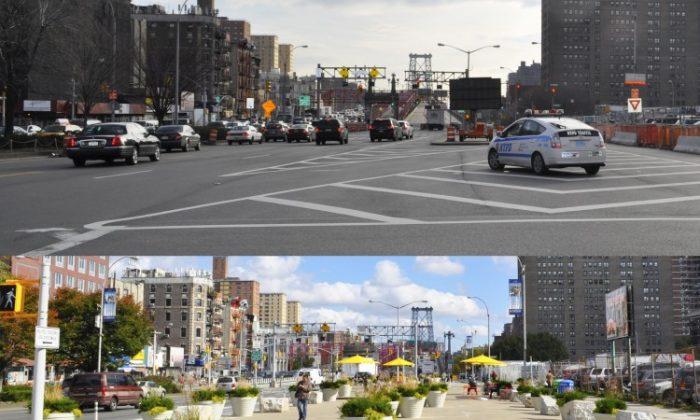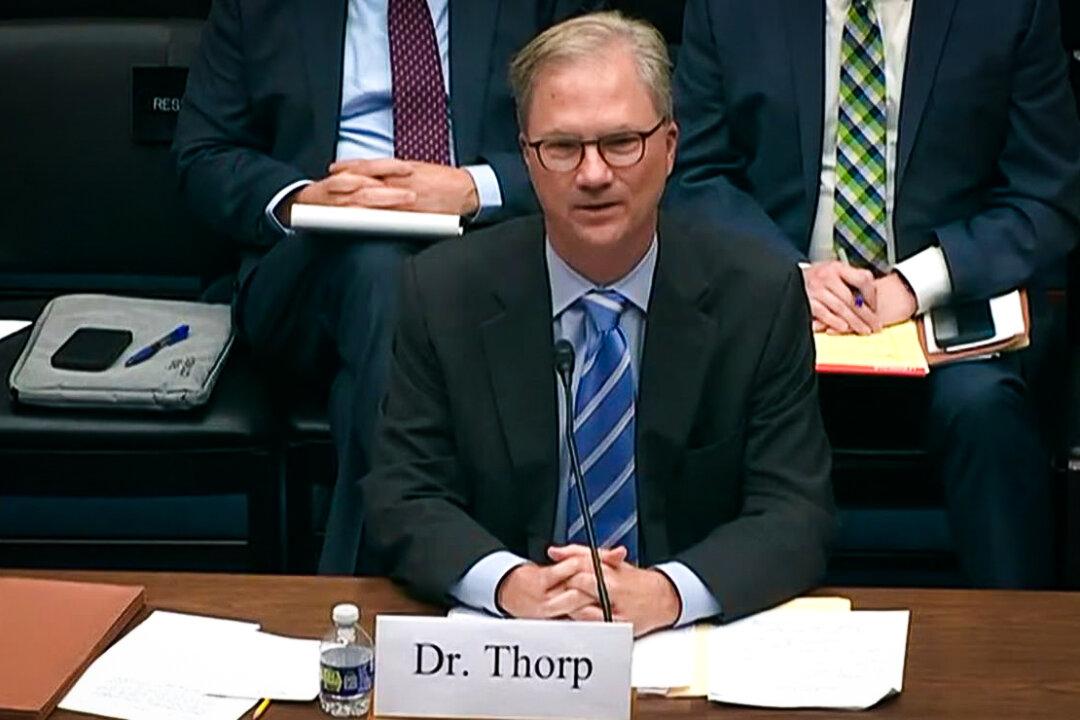NEW YORK—Decisions made by the Department of Transportation (DOT) have the potential to cause division in a neighborhood, even on a single block.
Some of the more difficult decisions involve bike lanes, bike corrals (sets of bike racks replacing parking spaces), wide pedestrian plazas, and slow zones with new speed limits of 20 miles per hour.
The changes DOT implements under Commissioner Janette Sadik-Khan’s leadership impact people’s lives, so naturally the agency attracts criticism from time to time.
Recently, many mayoral candidates have been keen to say that, if elected, they would rethink the DOT’s priorities.
For instance, several candidates would look at removing bike lanes that are not agreeable to the community. One candidate notably favors removing all bike lanes.
The various proposals frequently hinge on the argument that communities across the city are not involved enough in the decision-making process. The Epoch Times spoke to a number of community board representatives to learn what they think about community involvement.
The DOT did not respond to requests for an interview with Sadik-Khan.
Susan Stetzer, district manager for Manhattan Community Board 3, said she thinks Mayor Michael Bloomberg has made great improvement in community involvement for community boards. “It’s night and day from his predecessor—and I think it’s really important to acknowledge that,” she said, adding she hoped the next mayor would build on the increased level of consultation.
For Stetzer, some projects have gone well. A new pedestrian plaza has made crossing Delancey Street much easier, though it took a young girl’s death to spur the DOT into action, she said.
Community Board 3 has supported the DOT’s views on bike lanes, likely the most controversial of initiatives the department is in charge of, Stetzer said.
With regard to another issue, the board wants a car-free zone on Park Avenue, part of a Summer Streets initiative, switched from Saturday to Sunday, but nothing has happened according to Stetzer. The community feels the car-free zone interferes with business and shoppers, including the Union Square Greenmarket. Further, she said the jackhammering every weekend during the Houston Street reconstruction (a lesser known role of the DOT is street construction) is disturbing the peace.
Bob Gormley, district manager of Manhattan Community Board 2, said the board and DOT work well together.
“When proposals come up they consult us. When we pass resolutions, they generally follow our recommendations,” he said.
The department followed the board’s recommendation to deny applications for pop-up cafes, or areas of seating in parking spaces outside of restaurants, to all but one applicant.
“It’s a healthy [relationship],” he said. “I wish all city agencies dealt with community boards the way DOT does.”
The DOT staff work well with the community, but they don’t often ask for ideas, added Rodriguez, especially when a community is trying to do some redevelopment, or some rezoning, or re-shifting, he said. “And then when we do have ideas, it’s a lot of resistance.”
That’s not the experience of Rob Witherwax, co-chair of the transportation committee for Brooklyn Community Board 8.
“I have always been very impressed with DOT’s community outreach,” he said. “Out of all the city agencies I’ve dealt within nine years on the community board, they are by far most responsive and proactive in reaching out when they develop plans.”
During the redesign of Grand Army Plaza, at the northern edge of Prospect Park, the DOT worked closely with the community boards and local residents for years, said Witherwax.
He has also seen discontent about new initiatives in the community, such as a new bike corral on Franklin Avenue, which has rankled some local residents.
People are surprised, he said. For residents who are not up to date with what’s going on at the community board level who suddenly come out one morning, and there’s this change on the street—they ask “Why didn’t anyone tell me?” he explained.
Well, if they had gone to their community board meetings or kept apprised, they would have known in most circumstances, he said.
There are other cases where people say they weren’t consulted when they actually mean they weren’t given veto power over an initiative, said Robert Perris, district manager for Brooklyn Community Board 2.
There are other cases where the DOT doesn’t listen to the community board’s wishes at all. A bike lane on the congested thoroughfare on Hylan Boulevard on Staten Island should be removed, said Leticia Remauro, chair of Community Board 1. “Bike lanes are a great idea—if they’re located in the right place,” she said, adding that she favors lanes on streets with less traffic, such as Richmond Terrace.
Theresa Scavo, chair of Community Board 15 in Brooklyn, said she has experienced too many layers of bureaucracy when dealing with the DOT. A dangerous intersection at Kings Highway and Ocean Parkway was identified by the community in 2010, but the DOT didn’t look at it until 2013, she said.
“As far as the working relationship, not a problem, but everything takes too long to get resolved,” she said. “There are so many different channels that it has to go through before anything gets approved. I just think the red tape is so ingrained today that no one knows how to pick up a phone and say ‘Okay let’s just do it.’”
The Epoch Times publishes in 35 countries and in 21 languages. Subscribe to our e-newsletter.
Please send news tips to [email protected]










Friends Read Free